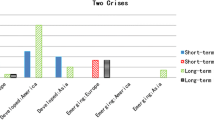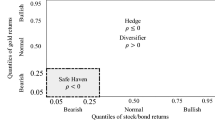Abstract
This paper examines the existence, intensity and international dependence of flight-to-quality from stocks to government bonds. To this end, we develop a two-state regime-switching bivariate copula model and apply it to the domestic and cross-country stock–bond return pairs of six developed countries (France, Germany, Japan, Switzerland, the UK and the US) over the period 1999–2019. We find that US and UK government bonds have played a primary role of safe-haven assets during stock market downturns. The remaining government bond markets show the evidence of flight-to-quality, but its intensity is relatively weak. Further, we find that although flight-to-quality tends to occur simultaneously in multiple countries, the frequency of the joint occurrence varies across government bond markets.


Similar content being viewed by others
Notes
Garcia and Tsafack (2011) analyze the dependence structure between four variables (stock and government bond returns of two countries). Extending our bivariate model to multivariate distributions requires substantial computational burden, and thus, we leave it to future work.
Durand et al. (2010) derive a copula function that combines Frank and Gumbel copulas to capture both a normal situation of positive correlation and a rare event of flight-to-quality between stock and bond markets. This is a very flexible model, but our RS copula model is more flexible in that asymmetric copulas other than Gumbel (Clayton and Joe in this paper) can be used for describing an asymmetric regime.
Hartmann et al. (2004) find that stock–bond contagion is approximately as frequent as flight-to-quality from stocks to bonds in G-5 countries over the period 1987–1999. However, our earlier analysis presents no evidence on the contagion over the period 1999–2019, and hence, this paper only studies flight-to-quality phenomena.
Note, however, that the differences between the unconditional means of the two returns do not affect the estimation result of the dependence structure because they are removed in the copula approach by filtering the conditional mean and variance of marginal distributions.
We do not report the standard errors and significance of the exceedance correlation estimates in the table because the t-test using the standard errors leads to the same result as the Wald test for \(H_0: \rho = \rho ^{\mathrm{{asy}}}_{\mathrm{{nor}}} = 0\).
See Appendix 1 in Longin and Solnik (2001) for the method to compute the optimal threshold values.
The starting value \(\xi _{1|0}\) is set equal to the vector of unconditional probabilities for two states, that is, \([(1-p_{22})/(2-p_{11}-p_{22}), (1-p_{11})/(2-p_{11}-p_{22})]'\).
To save space, we do not report the estimated coefficients on the ARMA and GARCH terms as they are relatively less informative. These results are available from the authors upon request.
The delta method is used to compute standard errors for the estimates of Kendall’s \(\tau \) and LU tail dependence.
There are two exceptions, UK–JP and US–JP (Table 10), for which incorrect estimates are obtained (bounded estimates of 0.5 for the transition probabilities and very large standard errors). Thus, for the two pairs, we regard the normal–asymmetric RS copula model reported in Panel A as the most appropriate model, but its normal regime, rather than the asymmetric one, as a regime to describe flight-to-quality events.
There are two slight differences, which are explained in the subsequent two footnotes. The whole of the results with a threshold value of 0.15 is available from the authors upon request.
When relying on the different definition of flight-to-quality with a threshold value of 0.15, there are three cases where domestic flight-to-quality simultaneously occurs in all countries.
For the different definition of flight-to-quality with a threshold value of 0.15, the ratio for Switzerland is low compared to the other three European countries. This suggests some degree of independence of Swiss financial markets from the three European countries.
References
Andersson, M., Krylova, E., Vähämaa, S.: Why does the correlation between stock and bond returns vary over time? Appl. Financ. Econ. 18, 139–151 (2008)
Aslanidis, N., Christiansen, C.: Smooth transition patterns in the realized stock–bond correlation. J. Empir. Finance 19, 454–464 (2012)
Bansal, N., Connolly, R.A., Stivers, C.: Regime-switching in stock index and treasury futures returns and measures of stock market stress. J. Futures Mark. 30, 753–779 (2010)
Baur, D.G., Lucey, B.M.: Flights and contagion—an empirical analysis of stock–bond correlations. J. Financ. Stab. 5, 339–352 (2009)
Bedford, T., Cooke, R.M.: Probability density decomposition for conditionally dependent random variables modeled by vines. Ann. Math. Artif. Intell. 32, 245–268 (2001)
Bedford, T., Cooke, R.M.: Vines—a new graphical model for dependent random variables. Ann. Stat. 30, 1031–1068 (2002)
Chang, C.-L., Hsueh, P.L.: An investigation of the flight-to-quality effect: evidence from Asia-Pacific countries. Emerg. Mark. Finance Trade 49, 53–69 (2013)
Chen, X.B., Silvapulle, P., Silvapulle, M.: A semiparametric approach to value-at-risk, expected shortfall and optimum asset allocation in stock–bond portfolios. Econ. Model. 42, 230–242 (2014)
Chiang, T.C., Li, J., Yang, S.-Y.: Dynamic stock–bond return correlations and financial market uncertainty. Rev. Quant. Financ. Acc. 45, 59–88 (2015)
Chollete, L., Heinen, A., Valdesogo, A.: Modeling international financial returns with a multivariate regime-switching copula. J. Financ. Econom. 7, 437–480 (2009)
Chui, C.M., Yang, J.: Extreme correlation of stock and bond futures markets: international evidence. Financ. Rev. 47, 565–87 (2012)
Connolly, R., Stivers, C., Sun, L.: Stock market uncertainty and the stock–bond return relation. J. Financ. Quant. Anal. 40, 161–194 (2005)
Connolly, R.A., Stivers, C., Sun, L.: Commonality in the time-variation of stock–stock and stock–bond return comovements. J. Financ. Mark. 10, 192–218 (2007)
Dajcman, S.: Comovement between Stock and bond markets and the ’flight-to-quality’ during financial market turmoil—a case of the eurozone countries most affected by the sovereign debt crisis of 2010–2011. Appl. Econ. Lett. 19, 1655–1662 (2012)
Durand, R.B., Junker, M., Szimayer, A.: The flight-to-quality effect: a copula-based analysis. Account. Finance 50, 281–299 (2010)
Fatum, R., Yamamoto, Y.: Intra-safe haven currency behavior during the global financial crisis. J. Int. Money Finance 66, 49–64 (2016)
Garcia, R., Tsafack, G.: Dependence structure and extreme comovements in international equity and bond markets. J. Bank. Finance 35, 1954–1970 (2011)
Glosten, L.R., Jagannathan, R., Runkle, D.E.: On the relation between the expected value and the volatility of the nominal excess return on stocks. J. Finance 48, 1779–1801 (1993)
Gulko, L.: Decoupling: If the U.S. treasury repays its debt, what then? J. Portf. Manag. 28, 59–66 (2002)
Hamilton, J.: Time Series Analysis. Princeton University Press, Princeton (1994)
Hansen, B.E.: Autoregressive conditional density estimation. Int. Econ. Rev. 35, 705–730 (1994)
Hartmann, P., Straetmans, S., de Vries, C.G.: Asset market linkages in crisis periods. Rev. Econ. Stat. 86, 313–326 (2004)
Ilmanen, A.: Stock–bond correlations. J. Fixed Income Fall 13, 55–66 (2003)
Jammazi, R., Tiwari, A.K., Ferrer, R., Moya, P.: Time-varying dependence between stock and government bond returns: international evidence with dynamic copulas. N. Am. J. Econ. Finance 33, 74–93 (2015)
Joe, H.: Multivariate Models and Dependence Concepts. Chapman & Hall, London (1997)
Joe, H.: Dependence Modeling with Copulas. CRC Press, Boca Raton (2015)
Joe, H., Xu, J.J.: The Estimation Method of Inference Functions for Margins for Multivariate Models. Technical Report No. 166, Department of Statistics, University of British Columbia (1996)
Jondeau, E., Rockinger, M.: The Copula-GARCH model of conditional dependencies: an international stock market application. J. Int. Money Finance 25, 827–853 (2006)
Kim, S.-J., Moshirian, F., Wu, E.: Evolution of international stock and bond market integration: influence of the European monetary union. J. Bank. Finance 30, 1507–1534 (2006)
Krupskii, P., Joe, H.: Factor copula models for multivariate data. J. Multivar. Anal. 120, 85–101 (2013)
Krupskii, P., Joe, H.: Structured factor copula models: theory, inference and computation. J. Multivar. Anal. 138, 53–73 (2015)
Longin, F., Solnik, B.: Extreme correlation of international equity markets. J. Finance 56, 649–676 (2001)
Nelsen, R.B.: An Introduction to Copulas. Springer, Berlin (2006)
Nguyen, P., Liu, W.: Time-varying linkage of possible safe haven assets: a cross-market and cross-asset analysis. Int. Rev. Finance 17, 43–76 (2017)
Ohmi, H., Okimoto, T.: Trends in stock–bond correlations. Appl. Econ. 48, 536–552 (2016)
Okimoto, T.: New evidence of asymmetric dependence structures in international equity markets. J. Financ. Quant. Anal. 43, 787–815 (2008)
Patton, A.J.: Modelling asymmetric exchange rate dependence. Int. Econ. Rev. 47, 527–556 (2006)
Patton, A.J.: Copula-based models for financial time series. In: Andersen, T.G., Davis, R.A., Kreiß, J.-P., Mikosch, T. (eds.) Handbook of Financial Time Series, pp. 767–785. Springer, Berlin (2009)
Ranaldo, A., Söderlind, P.: Safe haven currencies. Rev. Finance 14, 385–407 (2010)
Rodriguez, J.C.: Measuring financial contagion: a copula approach. J. Empir. Finance 14, 401–423 (2007)
Wu, C.-C., Lin, Z.-Y.: An economic evaluation of stock–bond return comovements with copula-based GARCH models. Quant. Finance 14, 1283–1296 (2014)
Acknowledgements
I am grateful to an anonymous referee for valuable comments and suggestions. I also acknowledge financial support from JSPS KAKENHI (Grant No.: 16K03746).
Author information
Authors and Affiliations
Corresponding author
Additional information
Publisher's Note
Springer Nature remains neutral with regard to jurisdictional claims in published maps and institutional affiliations.
Rights and permissions
About this article
Cite this article
Tachibana, M. Flight-to-quality in the stock–bond return relation: a regime-switching copula approach. Financ Mark Portf Manag 34, 429–470 (2020). https://doi.org/10.1007/s11408-020-00361-5
Published:
Issue Date:
DOI: https://doi.org/10.1007/s11408-020-00361-5




